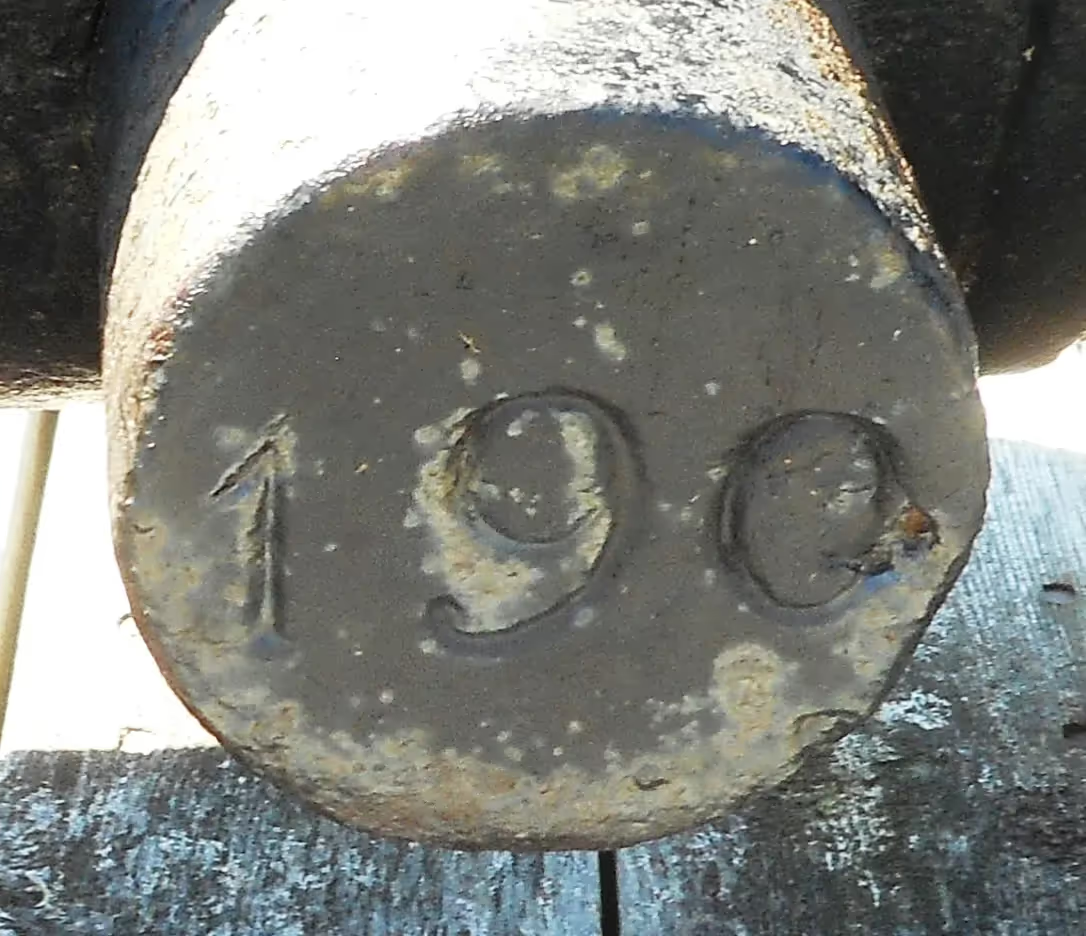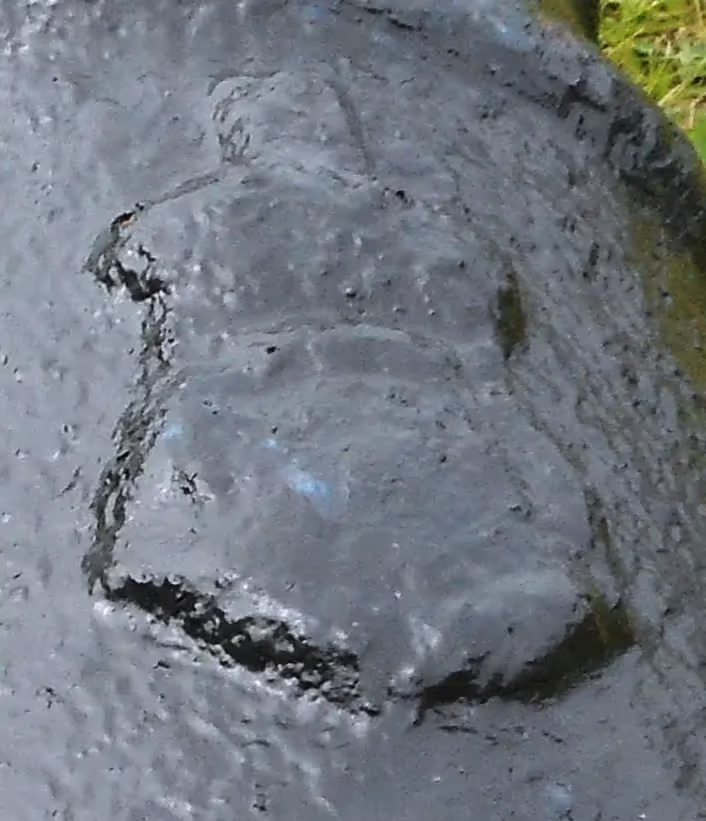Artillery in Canada (10) Newfoundland and Labrador: Placentia
Artillery in Newfoundland & Labrador, Placentia
For all official data concerning the Royal Regiment of Canadian Artillery, please click on the link to their website:
Royal Regiment of Canadian Artillery Website
The aim of this website is to locate, identify and document every historical piece of artillery preserved in Canada. Many contributors have assisted in the hunt for these guns to provide and update the data found on these web pages. Photos are by the author unless otherwise credited. Any errors found here are by the author, and any additions, corrections or amendments to this list of Guns and Artillery in Canada would be most welcome and may be e-mailed to the author at [email protected].
Note: Back in the day, artillery in Canada was referred to by its radio call sign "Sheldrake". It is now referred to by its "Golf" call sign. (Acorn)
Placentia


(Tom O'Keefe Photos)
German First World War 7.7-cm Feldkanone 96 neuer Art Field Gun (Serial Nr. 3690), R, D. Restored by the Highways Department with all metal wheels. According to a "Report of Disposition of War Trophies to 19 February 1921 (Journal of the House of Assembly of Newfoundland)", a captured German Field Gun (likely an FK 96) was sent to Placentia on 31 Dec 1920.

(Terry Honour Photo)
Cast Iron Smoothbore Muzzleloading Gun, heavily corroded, no visible markings, mounted on a wood naval gun carriage in front of the O'Reilly House Museum, No. 1 of 2.

(Terry Honour Photo)
Cast Iron Smoothbore Muzzleloading Gun, heavily corroded, no visible markings, mounted on a wood naval gun carriage in front of the O'Reilly House Museum, No. 2 of 2.
3-pounder QF Hotchkiss Gun on display at the Trade School.
Placentia, Fort Royal, Castle Hill National Historic Site

(Maxwell J. Toms Photos)
Placentia, named Plaisance by the French, was founded in 1662. It was established to protect French fishing interests in Newfoundland and was the French capital of Newfoundland during the 17th and 18th centuries. Using Plaisance as their home base, French forces successfully raided British settlements during times of war while Fort Royal, on top of Castle Hill, protected the colony from attack by British warships. In 1713, the French gave up their right to settlement in Newfoundland and established a new stronghold at Louisbourg on Cape Breton Island. British settlers replaced the French and their soldiers garrisoned the fortifications until 1811. Roughly 30 minutes away is Ship Harbour is where Winston Churchill and Franklin Roosevelt met to plan strategy during the Second World War.







Blomefield Cast Iron 12-pounder 34-cwt Smoothbore Muzzleloading Gun, weight 32-3-17 (3,685 lbs), Samuel Walker & Company of Rotherham, England (WCo) on the left trunnion, (Serial No. 190) on the right trunnion, King George III cypher, broad arrow mark. North East Bastion of the Castle Hill National Historic Site. Currently unmounted, a new gun carriage has been built for this gun by Nelson Sherren and Jim Steinhauer.

North West Bastion, Fort Royal, Castle Hill, with three unmounted smoothbore muzzleloading guns. (Maxwell J. Toms Photo)



(Terry Honour Photos)
Cast Iron 12-pounder 34-cwt Smoothbore Muzzleloading Gun, weight 33-0-1 (3,697 lbs), King George II cypher, broad arrow mark, “S.S. Louisbourg” on barrel. Castle Hill National Historic Site, No. 1 of 3 Guns in the North West Bastion.



(Maxwell J. Toms Photos)
Cast Iron 12-pounder 34-cwt Smoothbore Muzzleloading Gun, weight 33-0-20 (3,716 lbs), King George II cypher, broad arrow mark. Castle Hill National Historic Site, No. 2 of 3 Guns in the North West Bastion.




(Terry Honour Photos)
Cast Iron 12-pounder 34-cwt Smoothbore Muzzleloading Gun, weight 33-0-8 (3,708 lbs), King George II cypher, 15 beside it turned 90 degrees, broad arrow mark. Castle Hill National Historic Site, No. 3 of 3 Guns in the North West Bastion.





(Terry Honour Photos)
Cast Iron 9-pounder Smoothbore Muzzleloading Gun, weight 26-2-2 (2,970 lbs), C, Queen Anne cypher (1702 to 1714), broad arrow mark, mounted on wood naval gun carriages in the South East Bastion, No. 1 of 2.




(Terry Honour Photos)
Cast Iron 9-pounder Smoothbore Muzzleloading Gun, weight 25-3-0 (2,884 lbs), C, Queen Anne cypher (1702 to 1714), broad arrow mark, mounted on wood naval gun carriages in the South East Bastion, No. 2 of 2.






+ (Terry Honour Photos)
Cast Iron 9-pounder Smoothbore Muzzleloading Gun, weight 26-2-2 (2,970 lbs), C, Queen Anne cypher (1702 to 1714), 4 at a right angle to the cypher, broad arrow mark, mounted on wood naval gun carriages, guarding the front entrance to the Visitor's Centre.
Placentia, Fort Frederick
Fort Frederick is the site of an 18th century English fort situated on a point of land close to the harbour mouth. A stone and concrete monument flanked by two cannon mark the site.
The fort consisted of a semi-circular redoubt mounting twelve smoothbore muzzleloading guns, a guard house, barracks and storehouse surrounded by a palisade. It was erected on the town side of Placentia in 1717 to protect English interests in the seasonal fishery. However, as a permanent population on the island grew, the role of the military increasingly became one of maintaining public order and suppressing civil unrest. England withdrew its military garrisons from Newfoundland in 1870, thus paving the way for the establishment of a civilian police force.
Fort Frederick was the military headquarters in Newfoundland from 1721-1746. However, the fort was poorly maintained from the beginning and by 1744 the redoubt had to be strengthened by a timber and sod-work facing and the number of guns reduced to eight. Bastions were then added to the landward angles of the palisade, upon which were mounted Coehorn mortars (a mortar first used in 1674 which fired at a fixed angle of elevation of 45 degrees). After a partial repair in 1762 the works were allowed to decay and were finally abandoned in 1811 when the ordnance was removed. Two 12-pounder guns were mounted behind a temporary earthwork battery near this site in 1813 as protection against American privateers and can still be seen. Much of the Portland stone facing of the redoubt is incorporated in the fabric of the Placentia convent of the Presentation Sisters. (Town of Placentia Council, 7 Mar 1972)



(Terry Honour Photos)
Blomefield Cast Iron 12-pounder 34-cwt Smoothbore Muzzleloading Gun, weight 33-2-4 (3,756 lbs), maker unknown, King George II cypher, broad arrow mark, mounted on a wood gun carriage, No. 1 of 2, beside the Fort Frederick memorial marker.





(Terry Honour Photos)
Blomefield Cast Iron 12-pounder 34-cwt Smoothbore Muzzleloading Gun, weight 32-3-17 (3,685 lbs), Samuel Walker & Company of Rotherham, England (WCo) on left trunnion, (Serial No. 191) on right trunnion, ca. 1813, King George III cypher, mounted on an iron garrison carriage.
Placentia Bay
Cast Iron 4-inch Smoothbore Muzzleloading Gun, mounted on an iron garrison carriage, No. 1 of 2 in front of a Floral Design store.
Cast Iron 4-inch Smoothbore Muzzleloading Gun, mounted on an iron garrison carriage, No. 2 of 2 in front of a Floral Design store.



(Terry Honour Photos)
Cast Iron Smoothbore Muzzleloading Gun, possibly 6-pounder, crown and rose similar to Queen Anne's cypher (Stuarts and Hanoverians both adopted it- till George II's time), but cast in King George I's time, broad arrow mark, heavily corroded, mounted on a wood naval gun carriage, 8 feet long with a five inch bore (widened by subsequent re-use as post holders, or bollards), No. 1 of 2 in front of St. Luke's Church.



(Terry Honour Photos)
Cast Iron Smoothbore Muzzleloading Gun, 6-pounder, crown and rose similar to Queen Anne's cypher (Stuarts and Hanoverians both adopted it until King George II's time), but cast in King George I's time, broad arrow mark, heavily corroded, mounted on a wood naval gun carriage, 8 feet long with a five inch bore (been widened by subsequent re-use as post holders, or bollards), No. 2 of 2 in front of St. Luke's Church.





